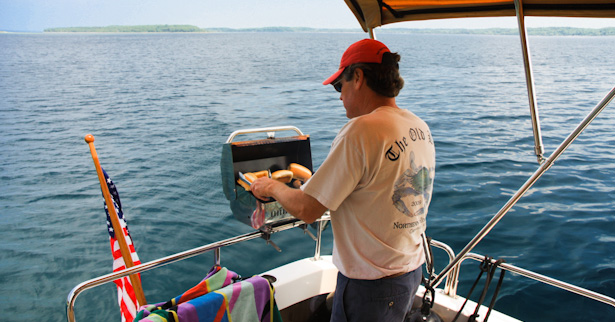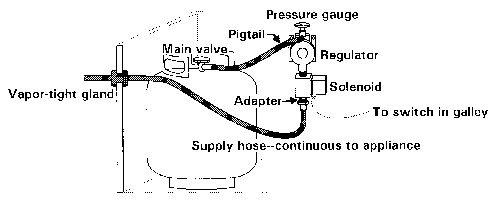Advertisement

Photo by Jim & Lisa Favors
Liquefied petroleum gas — generally propane in the United States — is the most convenient cooking fuel for a boat. It is available almost everywhere. It requires no pumping or preheating — ust turn the knob and light the burner. The heat is adjustable by lowering the flame. Ovens have a "ring" burner and can even be equipped with a broiler. And a gas stove, as every chef knows, is a joy to cook on.
On a boat, LPG is also, by far, the most dangerous cooking fuel. Propane and butane are heavier than air, so they "spill" like water. Leaking propane in a house falls to the floor, usually dispersing harmlessly on air currents, but a boat is like a bowl, and leaking gas accumulates in the bottom of it. One spark and KA-BOOM! Bits of boat rain down like a ticker-tape parade.
However, the popularity of LPG attests that you can minimize the risk of explosion with a proper installation and good safety habits.
Propane Tanks
The best place for a propane tank is in a vapor-tight locker isolated from the rest of the boat. The gas locker must open only above deck and must have a drain at the bottom to let leaking gas escape over the side. The drain outlet needs to be located away from any other hull opening and where it will always be above the water, even when the boat is heeled.

Mounting tanks on deck is another option, although this might not be as safe as it seems. Lying to current, or sailing or motoring downwind, gas leaking from an on-deck tank at the stern can be blown directly below. Bulwarks, coamings, and other deck features can keep leaking gas from spilling overboard, allowing it to find its way below through hatches, vents or lockers.. If you have or plan to have on-deck gas tanks, consider them critically.
Fiberglass or aluminum tanks are more suitable than steel for the marine environment. As a rule of thumb, expect to use about 1 pound of propane per person per week cooking three meals a day. So a full 10-pound tank should last a crew of two at least 5 weeks.
Pressure Gauge
A pressure gauge is an essential safety feature, and it must be the first thing connected to the valve on top of the bottle. It can be mounted directly on the bottle or installed on the locker wall and connected to the bottle with a high-pressure pigtail.
The gauge does not tell you the level of the gas in the tank; you weigh the tank to determine that. What the pressure gauge does do is allow you to easily — and frequently — leak test the LPG system.
Solenoid and Regulator
Next in line comes an electric solenoid that shuts off the gas inside the locker with the flip of a switch that's conveniently located in the cabin. Safe propane use means shutting off the gas at the tank after every use. You can do that manually by turning the knob on the tank-but you won't. Leaving the gas lines that run through your boat pressurized is risky business. The solenoid makes it easy to avoid this exposure. The switch should be paired with a bright panel light that warns you that the solenoid valve is open. The solenoid should always be off except when the stove is in use.
From the solenoid, the gas should flow directly into a step-down regulator that reduces the pressure from, say, 150 psi on the tank side (this varies widely with temperature) to less than 0.5 psi in the line that carries the gas to the galley stove or other appliance. This order can be reversed, with the solenoid plumbed after the regulator as shown in the illustration, but in my experience low-pressure solenoids tend to be of lesser quality. I also favor a high-pressure solenoid because it shuts off the gas upstream of the regulator and its connections. As a practical matter either configuration shuts off the gas inside the locker. If you do install your solenoid on the high-pressure side, be sure it is rated for high pressure.
Supply Hoses
The fuel line from the regulator (or solenoid valve) to the stove must be continuous--no connections inside the boat except at the stove. Solid copper fuel lines are used extensively in many parts of the world, but flexible, high-pressure hose is probably safer for boat use, and it is certainly easier to install.
A threaded adapter can be required to connect the hose to the regulator or solenoid. Use thread sealant on the regulator end of the adapter but not on the end that the hose attaches to. The rule is that when the threads form the seal, you need thread sealant, but not when the seal is formed with a flare, O-ring, or other compression fitting. Avoid Teflon tape in LPG plumbing as a loose bit of tape inside the hose will wreak havoc with burner valves.
The hose should exit the propane locker near the top, and it should pass through a vapor-tight fitting to prevent gas from leaking out of the locker into the interior of the boat. Use a similar fitting to protect the hose from abrasion everywhere it passes through a bulkhead.
Common straight-through fittings are too short to pass through a plywood bulkhead. You can thin the bulkhead by counterboring one side with a spade bit. Alternatively, cut an oversize hole through the bulkhead with a hole saw, screw a metal or fiberglass cover plate over the hole, and install the fitting through the cover plate.
Be sure to protect the hose from abrasion and excessive heat (140°F). LPG hose should run through the top of lockers rather than through their bottoms. Support the hose every 18 inches with nylon cable clamps.
Accessories
With a simple tee-connector between the solenoid and the main supply hose, you can connect an additional hose to supply a second propane appliance, a rail-mounted grill, for example. As with the main hose, the accessory hose must also exit the locker through a vapor-tight gland.
Propane barbecue grills designed for disposable propane canisters have their own regulators, so connecting the grill to the low-pressure side of the boat's propane system requires a low-pressure control valve — available from the grill manufacturer. It is possible to tee off the high-pressure side of the system, but this arrangement is not nearly as safe and should be avoided.
Here is a tip: a disposable canister can be used to supply all onboard propane appliances if you have a reverse cylinder adapter aboard. Disconnect the pigtail from the tank and fit the adapter to it, then screw on the canister and you are back in business. Having this adapter and a single propane canister aboard can get you through a weekend when you run out of gas unexpectedly.
Sniffers
Gas detectors add an additional level of safety to an LPG installation. So-called sniffers constantly monitor the air for the presence of LP gas, activating an alarm and shutting off the solenoid when they detect gas at about 10% of minimum explosive level.
Install the gas sensor where gas is likely to accumulate, i.e. as low as possible and near the range.
Use
To operate the system, the valve on the tank must be open. From inside the cabin, a flip of the solenoid switch allows the gas into the supply hose that feeds the stove. Open the burner valve and light the flame. When you are through cooking, leave one burner ignited and turn off the solenoid. When the burner goes out, close the burner valve. This empties the line of gas so that none will leak into the bilge should a burner valve fail to seal.
If you will leave the boat unattended for a while, it is a good practice to close the valve on the tank to eliminate all risk of undetected leakage.
Testing
If you are using the stove regularly, you should make a habit of testing the system for leaks. Once a week is not too often.
To test the system, operate the stove, then close all the burner valves, but leave the solenoid switch on. Read the pressure gauge, then turn off the manual valve on the tank. After 3 minutes, read the pressure again. If it is unchanged, wait 15 minutes and read it again. Any drop in pressure indicates a leak that must be located (with soapy water) and stopped. If the system is leak-free, reopen the tank valve, light a burner, then shut off the solenoid as normal.
BoatUS Members save at Boat Shows
Make sure to mark your calendars for two exciting events! The code for both shows is 25BOATUS (not case sensitive). This is a $5 discount that applies to Preview Day, General Admission, Preview Combo, and General Admission Combo tickets.
